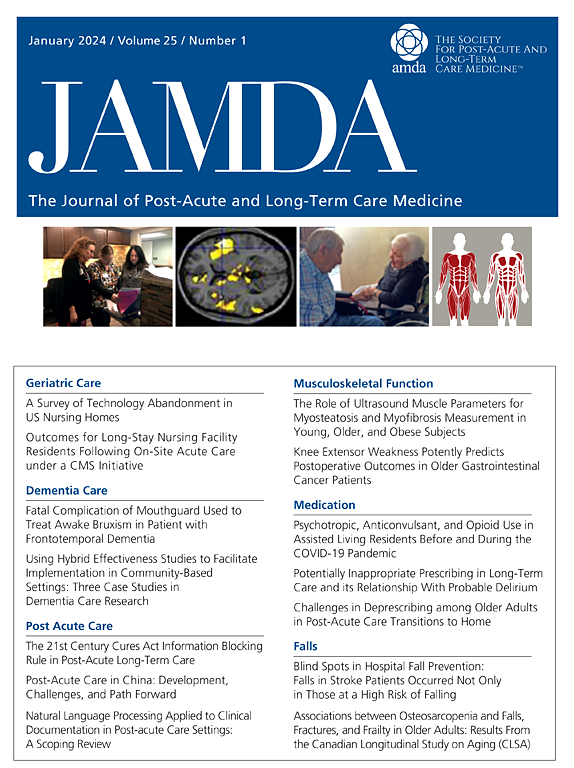为专业护理机构患者开发住院预测模型。
IF 4.2
2区 医学
Q2 GERIATRICS & GERONTOLOGY
Journal of the American Medical Directors Association
Pub Date : 2024-09-27
DOI:10.1016/j.jamda.2024.105288
引用次数: 0
摘要
目的:由于质量标准、经济处罚和临床人员有限等原因,识别有住院或死亡风险的专业护理机构(SNF)患者是 SNF、患者和患者家属关心的问题。我们的目标是开发一种预测模型,用于识别可能在未来 7 天内住院或死亡的 SNF 患者,并根据临床医生的判断验证该模型的性能:设计:回顾性多变量预后模型开发研究:环境和参与者:使用 PointClickCare 电子健康记录 (EHR) 系统的美国 SNF 中的患者。我们使用了从 2019 年 1 月 1 日到 2023 年 3 月 31 日期间 8440 家 SNF 中 5642474 名患者熟练住院头 100 天的数据:我们利用在临床护理过程中收集的数据开发了一个机器学习模型,用于预测患者在未来 7 天内住院或死亡的可能性。这些数据包括生命体征、诊断、实验室结果、食物摄入量和临床笔记。作为对比,我们还请 SNF 护士和医院病案经理进行了预测。电子病历是患者死亡或住院的信息来源:该模型的灵敏度为 35%,特异度为 92%,阳性预测值 (PPV) 为 18%,接收者运算曲线下面积 (AUC) 为 0.75。在该模型的变体中,我们没有将进展记录和食物摄入量包括在内,其 AUC 为 0.70。护士评分员的灵敏度为 61%,特异性为 73%,PPV 为 10%:机器学习模型可以准确预测SNF患者未来7天内住院或死亡的可能性。这些模型不需要SNF员工花费额外的时间,而且可以针对风险最高的患者主动进行更频繁的监测,从而在减少再入院计划中发挥作用。本文章由计算机程序翻译,如有差异,请以英文原文为准。
Development of a Predictive Hospitalization Model for Skilled Nursing Facility Patients
Objectives
Identifying skilled nursing facility (SNF) patients at risk for hospitalization or death is of interest to SNFs, patients, and patients' families because of quality measures, financial penalties, and limited clinical staffing. We aimed to develop a predictive model that identifies SNF patients likely to be hospitalized or die within the next 7 days and validate the model's performance against clinician judgment.
Design
Retrospective multivariate prognostic model development study.
Setting and Participants
Patients in US SNFs that use the PointClickCare electronic health record (EHR) system. We used data from the first 100 days of skilled stays for 5,642,474 patients in 8440 SNFs, from January 1, 2019, through March 31, 2023.
Methods
We used data collected in the course of clinical care to develop a machine learning model to predict the likelihood of patient hospitalization or death within the next 7 days. The data included vital signs, diagnoses, laboratory results, food intake, and clinical notes. We also asked SNF nurses and hospital case managers to make their own predictions as a comparison. The EHR was used as the source of information on whether the patient died or was hospitalized.
Results
The model had sensitivity of 35%, specificity of 92%, positive predictive value (PPV) of 18%, and area under the receiver operator curve (AUC) of 0.75. A variation of the model in which we did not include progress notes and food intake achieved an AUC of 0.70. Nurse raters achieved a sensitivity of 61%, specificity of 73%, and PPV of 10%.
Conclusions and Implications
Machine learning models can accurately predict the likelihood of hospitalization or death within the next 7 days among SNF patients. These models do not require additional SNF staff time and may be useful in readmission reduction programs by targeting more frequent monitoring proactively to those at highest risk.
求助全文
通过发布文献求助,成功后即可免费获取论文全文。
去求助
来源期刊
CiteScore
11.10
自引率
6.60%
发文量
472
审稿时长
44 days
期刊介绍:
JAMDA, the official journal of AMDA - The Society for Post-Acute and Long-Term Care Medicine, is a leading peer-reviewed publication that offers practical information and research geared towards healthcare professionals in the post-acute and long-term care fields. It is also a valuable resource for policy-makers, organizational leaders, educators, and advocates.
The journal provides essential information for various healthcare professionals such as medical directors, attending physicians, nurses, consultant pharmacists, geriatric psychiatrists, nurse practitioners, physician assistants, physical and occupational therapists, social workers, and others involved in providing, overseeing, and promoting quality

 求助内容:
求助内容: 应助结果提醒方式:
应助结果提醒方式:


